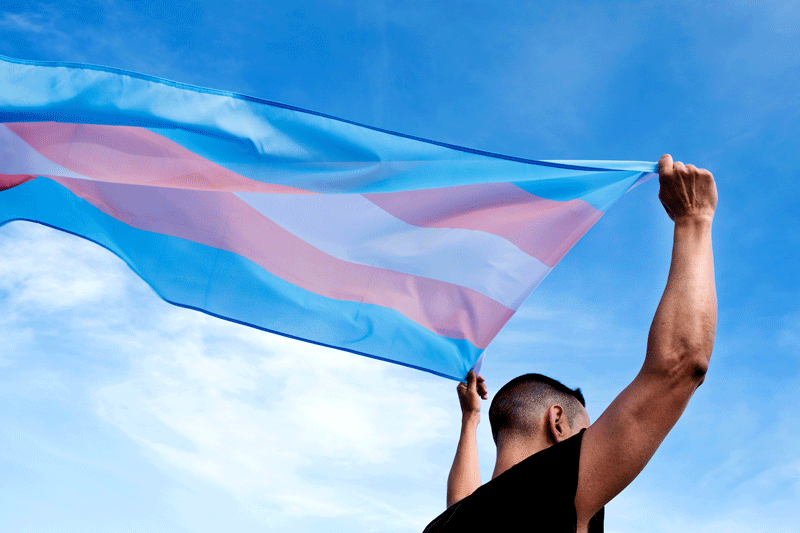When partners begin neurodiverse couples therapy, they bring a myriad of topics into the session. As a therapist specializing in gender and sexuality, I often hear couples discussing challenges related to intimacy and sex. However, what happens when one partner realizes they do not fully identify with their sex assigned at birth? This article will explore the process of identifying gender differences, integrating those new gender roles and identities into the relationship, and ways this may impact intimacy and sexuality. In a time when gender non-conformity is highly publicized and criticized, we will focus specifically on gender-affirming approaches and the range of emotions and experiences that may come up throughout this process for both the trans individual and their partner.

Identifying Gender Identity
Many individuals do not have the ability nor insight to pause and truly consider who they are internally (gender) and instead live life as the sex they were ascribed at birth. For individuals whose gender is not congruent with their birth sex, this is not a choice but rather a deeper understanding and awareness of who they truly are. In order to speak about the diversity of gender experience, this article will use the words “transgender” and “gender diverse” to describe individuals who identify as transgender, gender non-binary, gender nonconforming, gender questioning/curious, etc. Gender is a nuanced construct that needs to be thoroughly explored for each individual. Everyone uses different language to describe their unique gendered experience. When working with someone who is gender diverse, it is most appropriate to utilize the language they use to define their own identity. Only they know who they are and how to describe their gender.
When someone with Autism Spectrum Disorder (ASD) is also gender nonconforming, they may have felt “othered” in multiple domains of their life. While this is not everyone’s experience, in my clinical practice, I often see individuals diagnosed with ASD who then recognize there is still something different about their life experience. Research shows that individuals who are gender diverse have higher rates of autism than a cisgender or individuals whose birth sex and gender identity are congruent counterparts (Warrier et al., 2020). Kallitsounaki and Williams (2022) conducted a meta-analysis that found the prevalence of autism within the gender-diverse community was as high as 11%. While research on ASD and gender has nearly doubled in the last two years, there needs to be ongoing research on their co-occurrence and potential social and cultural implications. (Kallitsounaki and Williams, 2022).
For clinicians, inquiring about gender and pronouns is not only useful but also best practice. Clinicians ask a variety of questions on intake paperwork and should incorporate questions regarding an individual’s gender and sexual identity. This demonstrates awareness and understanding, and it begins to set up a safe, supportive therapeutic space to have these conversations during sessions. It communicates in writing that this topic will be addressed therapeutically. Research has shown that suicidality in transgender populations is significantly higher than in cisgender individuals (Bränström et al., 2022). In addition, we know that autistic individuals have higher rates of suicidality. In 2021, South et al. “report adjusted incidence rate ratios (aIRRs) more than 3 times higher among individuals with autism for both suicide attempts and deaths, with significantly higher rates compared with the general population across all age ranges, beginning from age 10 years.” This data suggests that individuals with both autism and gender differences are not just feeling “othered” but that these experiences can have an impact on their mental health, well-being, and life expectancy.
For clients, considering how one identifies gender identity and sexual interest allows for a deeper understanding of the self and can bring up helpful conversation topics for therapeutic work. As an example, if a neurodiverse couple is working on splitting up daily household tasks but have markedly different gender role expectations of housework, their perspectives will add another layer of complexity to this challenge. Many neurodiverse couples therapists will focus on the executive functioning of both partners and how to organize their schedules instead of on more deeply rooted thoughts and ideas about gender and gender roles that could impact one or both of their viewpoints.
Once a trans individual’s internal identity is explored, the next step is discussing how they want to express or explore their gender. For some people, their gender can all come out at once. For others, it is a longer-term adjustment or self-discovery of who they are and how they want to live their lives. This may look like someone coming out as non-binary or gender non-confirming first and then later expressing a desire for more of a gendered transition. Others know exactly how they feel about their gender and want to move forward with living more authentically as soon as they make the disclosure. The concept of “transitioning” has a different meaning for each individual. For some people, it may mean changing the way they dress or the pronouns they use. For others, it could mean taking hormones or having gender-affirming surgical procedures. There is no “right” way to transition, and it is a deeply personal choice for each individual.
Understanding and Reframing Gender in the Relationship
Many people who are gender diverse may have felt different from their peers earlier in life before expressing their thoughts and feelings to family or a significant other. This can translate into an individual spending a period of time personally and/or therapeutically exploring their gender identity before the information is given to a partner. A spouse could receive information about gender diversity at the point that their partner is ready to transition or move forward with external gender changes. While cisgender partners may display a range of reactions, it often takes some amount of their own processing time to truly understand what this means for their partner, themselves, and the relationship. Many partners express feeling surprised or caught off guard by revelations of gender and need time to shift their paradigm. In addition to couples therapy, I typically encourage each partner to access additional support, individual therapy, groups, etc., to continue their own therapeutic work on understanding and incorporating this information.
Gender and Sexuality
When an individual comes out as gender diverse, they are still the same person. However, a fundamental part of their identity needs to be reframed and fully understood. Their public identity in the world may have shifted. What does this mean for their partner? Did they previously identify as straight and now identify as gay? Did their sexual orientation not change at all? Are they still attracted to their specific partner but not to others of that gender? The act of considering sexuality and identity within a relationship can be challenging but can also be gender-affirming to the trans individual, as their partner is seeing that their gender is different from what they originally understood it to be
When a partner’s gender changes, their cisgender spouse often needs to consider their own internal sense of sexuality and attraction. Attraction comes in many different forms, from intellectual or emotional to sexual. For some individuals, sexuality can be on a spectrum. They can experience attraction to a wider range of attributes than they previously thought or knew about themselves. For others, attraction is limited and inflexible. The experience of internal feelings of connection and attraction is deeply personal, and only the individual in that experience can say exactly how they feel toward another person. Sometimes, partners are surprised by their flexibility in sexuality and feelings of desire for their partner post-transition, while others struggle to experience the same level of connection they previously had for their spouse.
If a neurotypical, cisgender woman is married to an autistic man who comes out as a woman, the neurotypical woman is no longer in a heteronormative presenting relationship. This does not mean her internal sense of self or sexuality changes, but the way she presents herself to the world will be as a woman married to a woman. Others may perceive her sexuality to be somewhere on the LGBTQ spectrum when that may or may not be reflective of her sexuality.
Conclusion
Gender and sexuality are complex constructs. Every person in the world has both a gender and a sexuality. Sometimes, it is very clear from early on, and for others, it shifts and changes throughout life. As therapists, it is our duty to address all parts of our clients, including their gendered and sexual identities. This work can be especially powerful and supportive for neurodivergent couples who are facing gender transitions within their long-term relationships. By exploring both partners internal senses of self, we allow couples to more fully understand one another and the emerging dynamics in their relationship. Gender-affirming neurodiverse couples therapy allows couples to work toward incorporating changes in gender and sexuality within the relationship framework or help couples have conversations about ending or shifting the dynamics in their partnership.
Leslie Sickels, LCSW works with neurodiverse couples and individuals on the autism spectrum in New York. For more information about Leslie’s therapeutic work and neurodiverse couples therapy visit LeslieSickelsLCSW.com.
References
Bränström, R., Stormbom, I., Bergendal, M., & Pachankis, J. (2022). Transgender‐based disparities in Suicidality: A population‐based study of key predictions from four theoretical models. Suicide and Life-Threatening Behavior, 52(3), 401–412. https://doi.org/10.1111/sltb.12830
Kallitsounaki, A., & Williams, D. M. (2022). Autism spectrum disorder and gender dysphoria/incongruence. A systematic literature review and meta-analysis. Journal of Autism and Developmental Disorders, 53(8), 3103–3117. https://doi.org/10.1007/s10803-022-05517-y
South M, Costa AP, McMorris C. (2021) Death by Suicide Among People With Autism: Beyond Zebrafish. JAMA Network Open. 4(1):e2034018. doi:10.1001/jamanetworkopen.2020.34018
Warrier, V., Greenberg, D. M., Weir, E., Buckingham, C., Smith, P., Lai, M.-C., Allison, C., & Baron-Cohen, S. (2020). Elevated rates of autism, other neurodevelopmental and psychiatric diagnoses, and autistic traits in transgender and gender-diverse individuals. Nature News. https://www.nature.com/articles/s41467-020-17794-1






